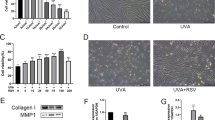Summary
Transforming growth factor (TGF)-β signaling plays an important role in the pathogenesis of psoriasis. CD109, a novel TGF-β co-receptor, which inhibits TGF-β signaling by enhancing Smad7-dependent degradation of TGF-β type I receptor (TGF-β RI), is abnormally expreβsed in psoriasis. To date, the expreβsion of Smad7 and the correlation between CD109 and Smad7 expreβsion in psoriasis have not been fully elucidated. This study was designed to investigate the expreβsion and the correlation of CD109 and TGF-β signaling aβsociated proteins in psoriasis and their roles in the pathogenesis of psoriasis. Thirty-two psoriasis specimens were subjected to immunohistochemical staining for CD109, Smad7, TGF-β RI and Ki67. Ten normal skin (NS) specimens served as controls. The positive expression rate (% positive cells) of Smad7 and Ki67 in psoriasis was significantly higher than in NS (62.6%±19.9% vs. 17.2%±4.4%, and 50.7%±14.3% vs. 19.5%±3.2%, respectively, P<0.001), and the expression levels of CD109 and TGF-β R? were reduced significantly in psoriasis as compared with NS (8.1%±6.7% vs. 35.8%±6.7% and 27.3%±3.4% vs. 3.0%±3.4%, respectively, P<0.001). There were significantly negative correlations between CD109 and Smad7 (r=-0.831, P<0.01). These findings indicated that CD109 might play a certain role in the pathogenesis of psoriasis. Lower expression of CD109 and TGF-β RI was highly correlated with higher expression of Smad7 and Ki67, suggesting that CD109 may induce the pathogenesis of psoriasis through Smad7-mediated degradation of TGF-β RI, and lead to the termination of TGF-β signaling.
Similar content being viewed by others
References
Nestle FO, Kaplan DH, Barker J. Psoriasis. N Engl J Med, 2009,361(15):496–509
Yue J, Mulder KM. Transforming growth factor-beta signal transduction in epithelial cells. Pharmacol Ther, 2001,91(1):1–34
Biernacka A, Dobaczewski M, Frangogiannis NG. TGF-β signaling in fibrosis. Growth Factors, 2011,29(5):196–202
Penn JW, Grobbelaar AO, Rolfe KJ. The role of the TGF-β family in wound healing, burns and scarring: a review. Int J Burns Trauma, 2012,2(1):18–28
Buβse A, Keilholz U. Role of TGF-β in melanoma. Curr Pharm Biotechnol, 2011,12(12):2165–2175
Zhang Y, Meng XM, Huang XR, et al. Transforming growth factor-β1 mediates psoriasis-like lesions via a Smad3-dependent mechanism in mice. Clin Exp Pharmacol Physiol, 2014,41(11):921–932
Shi Y, Massagué J. Mechanisms of TGF-beta signaling from cell membrane to the nucleus. Cell, 2003,113(6): 685–700
Doi H, Shibata MA, Kiyokane K, et al. Downregulation of TGFbeta isoforms and their receptors contributes to keratinocyte hyperproliferation in psoriasis vulgaris. J Dermatol Sci, 2003,33(1):7–16
Chong PA, Lin H, Wrana JL, et al. An expanded WW domain recognition motif revealed by the interaction between Smad7 and the E3 ubiquitin ligase Smurf2. J Biol Chem, 2006,281(25):17 069–17 075
Luo L, Li N, Lv N, et al. SMAD7: a timer of tumor progreβsion targeting TGF-β signaling. Tumour Biol, 2014,35(9):8379–8385
Lin M, Sutherland DR, Horsfall W, et al. Cell surface antigen CD109 is a novel member of the alpha(2) macroglobulin/C3, C4, C5 family of thioester-containing proteins. Blood, 2002,99(5):1683–1691
Mokrosinski J, Krajewska WM. TGF beta signalling accessory receptors. Postepy Biochem, 2008,54(3):264–273
Hashimoto M, Ichihara M, Watanabe T, et al. Expression of CD109 in human cancer. Oncogene, 2004,23(20): 3716–3720
Ohshima Y, Yajima I, Kumasaka MY, et al. CD109 expression levels in malignant melanoma. J Dermatol Sci, 2010,57(2):140–142
Ozbay PÖ, Ekinci T, Yigit S, et al. Investigation of prognostic significance of CD109 expression in women with vular squamous cell carcinoma. Onco Targets Ther, 2013,6:621–627
Finnson KW, Tam BY, Liu K, et al. Identification of CD109 as part of the TGF-beta receptor system in human keratinocytes. FASEB J, 2006,20(9):1525–1527
Bizet AA, Liu K, Tran-Khanh N, et al. The TGF-β co-receptor, CD109, promotes internalization and degradation of TGF-β receptors. Biochim Biophys Acta, 2011,1813(5):742–753
Bizet AA, Tran-Khanh N, Saksena A, et al. CD109-mediated degradation of TGF-β receptors and inhibition of TGF-β responses involve regulation of SMAD7 and Smurf2 localization and function. J Cell Biochem, 2012,113(1):238–246
Litvinov IV, Bizet AA, Binamer Y, et al. CD109 release from the cell surface in human keratinocytes regulates TGF-β receptor expreβsion. TGF-β signalling and STAT3 activation: relevance to psoriasis. Exp Dermatol, 2011,20(8):627–632
Tam BY, Philip A. Transforming growth factor-beta receptor expression on human skin fibroblasts: dimeric complex formation of type I and type II receptors and identification of glycosyl phosphatidylinositol-anchored transforming growth factor-beta binding proteins. J Cell Physiol, 1998,176(3):553–564
Hagiwara S, Murakumo Y, Mii S, et al. Processing of CD109 by furin and its role in the regulation of TGF-beta signaling. Oncogene, 2010,29(15):2181–2191
Jinnin M. Mechanisms of skin fibrosis in systemic sclerosis. J Dermatol, 2010,37(1):11–25
Man XY, Finnson KW, Baron M, et al. CD109, a TGF-β co-receptor, attenuates extracellular matrix production in scleroderma skin fibroblasts. Arthritis Res Ther, 2012,14(3):R144
Leivo T, Leivo I, Kariniemi AL, et al. Down-regulation of transforming growth factor-beta receptors I and II is seen in lesional but not non-lesional psoriatic epidermis. Br J Dermatol, 1998,138(1):57–62
Feng AP, He YM, Liu XX, et al. Expreβsion of USP15, TβR-I and Smad7 in psoriasis. J Huazhong Univ Sci Technolog Med Sci, 2014,34(3):415–419
Kavsak P, Rasmussen RK, Causing CG, et al. Smad7 binds to Smurf2 to form an E3 ubiquitin ligase that targets the TGF beta receptor for degradation. Mol Cell, 2000,6(6):1365–1375
Ebisawa T, Fukuchi M, Murakami G, et al. Smurf1 interacts with transforming growth factor-beta type I receptor through Smad7 and induces receptor degradation. J Biol Chem, 2001,276(16):12477–12480
Author information
Authors and Affiliations
Corresponding author
Additional information
This project was supported by the National Natural Science Foundation of China (No. 81101191, and No. 30972654).
The authors contributed equally to this work.
Rights and permissions
About this article
Cite this article
Liu, Xx., Feng, Ap., He, Ym. et al. Association of down-regulation of CD109 expression with up-expression of Smad7 in pathogenesis of psoriasis. J. Huazhong Univ. Sci. Technol. [Med. Sci.] 36, 132–136 (2016). https://doi.org/10.1007/s11596-016-1555-1
Received:
Revised:
Published:
Issue Date:
DOI: https://doi.org/10.1007/s11596-016-1555-1




